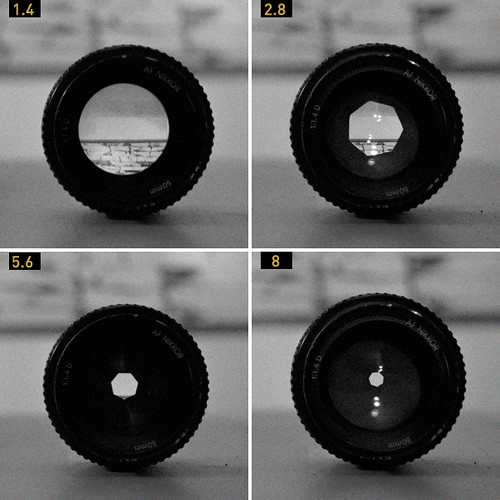For now --- What is f stop? I will take a couple of posts to explain and really explore f stop. This is one of those things like Chemistry class for some pre-med students... or the Eagle Project that never got done... It is where people seem to hit a wall of understanding, give up, and go back to plan b.
So how do we grasp it? First; trust me that it is really not unsurmountable. And please don't close your eyes, because we won't say the 'm' word. {a-hum,
Let's go back to our common ground with cameras... our eyes. The size of your pupil determines how much light enters your eyes. Your brain has a built in light meter and relay system that is very responsive... except for first thing in the morning when that system has been resting all night. If you look into a bright light, your pupils rapidly constrict down because of the meter in your head that is protecting your retina from too much light. In order to make out any detail, we need to have just the right amount of light. Too much is overwhelming and all we see is white. Not enough fails to illuminate the small details. It's all about recording reflected light on our retina. In camera terms, it's about getting the right amount of reflected light to the recording sensor (in digital) or to the film.
Contrast the eye with a video camera - or your point and shoot camera. Think of what happens when you point the camera to someone in a room - and then to the window.
The light outside is far brighter, but it takes about a second for that iris to close down so that it's not just a 'blown-out' white. After a second, the iris has closed down a bit and the correct colors and lighting outside are seen.
But what happens to the inside? It becomes underexposed and maybe even black. So the camera is an all-or-none deal. One setting, one aperture. The above picture is exposing for the person inside the room (with less light reflecting off of the subject). While the other image has more light outside and the exposure is adjusted to that outdoor light, leaving the indoor detail underexposed and undetected.
APERTURE: the size of the opening of the iris.
Terminology time:
Just like in our eyes, the brighter the subject, the more closed the aperture needs to be.
THE NUMBER GAME:
The f stop (sometimes called the f number) of the camera is a number such as 1.4, 2.8, 3.5, on up to 22. It is really a fraction. Oh no, fractions! Take a deep breath... It just means that if I am opening the aperture to an f stop of 22, it is really 1/22. Said in other terms... if I have a pecan pie in a glass dish and I shining a light on the other side of the dish. I cut the pie into 22 pieces. Only 1 of those pieces is missing, and the light can only shine through that one section of the pie. That's a really small iris, opening, or aperture. If I open the aperture up to 3.5, it is really 1/3.5. That means I cut the pie into 3.5 pieces. Then I take 1 away. That leaves a larger gap (or opening) for the light to shine through. One of three is much larger than 1 of 22.
Instead of a pie dish, your camera has a glass lens. And instead of pie, it has blades that open up or close down to make the aperture smaller or larger.
Here are some example of iris size and their f stops shown upper left.
The larger the aperture, the smaller the f number or f stop. 22 is tiny aperture. 1.4 is all the way open - or very large aperture.
This begs the question of why is the highest f stop 1.4 and not 1? Wouldn't 1 be totally open? Well, yes, but as far as I know, 1.4 is the larges it can go. The blades on the iris open, but don't retract.
For more explanation on calculating the f stop (or f number) click here.
In this post, we only talked about f stop in regards to light gathering. The smaller the f stop, the more light is able to reach the sensor (where the image is recorded). Thus if my picture is overexposed or too bright, I could stop down the f stop to a larger number to let less light in.
F stop essentially affects two things... light entering the camera and depth of focus. Today we just spoke of f stop in regards to light. At another date we will try and tackle the depth of focus. It is critical, but can be difficult to explain.
Pic of the Day
taken at f 1.4






1 comment:
Click here for a basic tutorial to catch up to speed.
Post a Comment